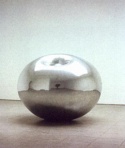

Steel is often classified by its carbon content: a high-carbon steel is serviceable for dies, cutting, and carving tools because of its great hardness and brittleness; low- or medium-carbon steel is used for sheet metal and structural forms because it is easily and effectively welded. Alloy steels, now most widely used, contain one or more other elements to give them specific qualities. Aluminum steel is smooth and has a high tensile strength. Chromium steel finds wide use in automobile and airplane parts on account of its hardness, strength, and elasticity, as does the chromium-vanadium variety. Nickel steel is the most widely used of the alloys; it is nonmagnetic and has the tensile strength of high-carbon steel without the brittleness. Nickel-chromium steel possesses a shock resistant quality that makes it suitable for armor plate. Wolfram (tungsten), molybdenum, and high-manganese steel are other alloys. Stainless steel, which was developed in England, has a high tensile strength and resists abrasion and corrosion because of its high chromium content.
Some of the other types available include mild steels. Among these Cor-ten has been particularly popular for outdoor structures (sculptural and architectural) for two reasons. First, Cor-ten oxidizes to a handsome chocolate brown. Secondly, many authorities have said that when rust on Cor-ten reaches a certain depth, it develops a sealing quality that protects it from further corrosion. Despite such claims that it has a higher resistance to atmospheric corrosion than typical mild steels, numerous works in Core-ten have corroded in undesireable ways.
Steel can be purchased in several forms, including sheets and plates, wires and rods, tubes or pipes, extrusions and castings. Pieces of steel are typically joined by welding, or with nuts and bolts, or with rivets.
Examples of works in steel:

Europe (possibly Scandinavian), Sword, 10th century, steel, copper,
silver, length
37 3/4 inches (96 cm), Metropolitan Museum of Art, NY. See arms and armor.

Iran, Helmet, late 15th century, Ak-Koyunlu/Shirvan
period, steel, engraved
and damascened with silver,
height 13 3/8 inches (34
cm), Metropolitan Museum of Art, NY.

Filippo Negroli (Italian, c. 1510-1579, Milan),
Burgonet, 1543, steel, embossed
and damascened with gold,
height 9 1/2 inches (24.1
cm), weight 4 pounds
2 ounces (1.9 kg), Metropolitan
Museum of Art, NY.

Attributed to Iran, Safavid, Plaque, 17th century, cut and pierced
steel, length 15 inches
(38.1 cm), Metropolitan Museum of Art, NY. See Islamic art and plaque.
José de Rivera (American, 1904-1985)

David Smith (American, 1906-1965), Becca, 1965, stainless steel, 113 1/4
x 123 x 30 1/2 inches (287.7 x 312.4 x 77.5 cm), Metropolitan
Museum of Art, NY. See Abstract
Expressionism.
Tony Smith (American, 1912-1980). See Minimalism.
Anthony Caro (English, 1924-), Potpourri, 1976-77, welded steel, rusted and varnished, 57 x 102 x 134 inches, Grounds For Sculpture, NJ. See English art.

Anthony Caro, Odalisque, 1984, steel, 77 x 96 x 60
1/2 inches (195.6 x 243.8 x 153.7 cm), Metropolitan Museum of
Art, NY. See odalisque.

David Annesley (English, 1936-), Swing Low, 1964, painted steel, 128.3
x 175.9 x 36.8 cm, Tate Modern, London.
Richard Serra (American, 1939-).

Anish Kapoor (British, born India, 1954-
), Turning
the World Inside Out, 1995, cast
stainless steel, 3/3 (third in an edition
limited to three), 60
x 70 inches (152.4 x 177.8cm), Santa Barbara Museum of Art, CA.
Also see galvanize, patina, rust, charts of steel sheet gauges and steel wire gauges, texture, and wrought iron.
https://inform.quest/_art